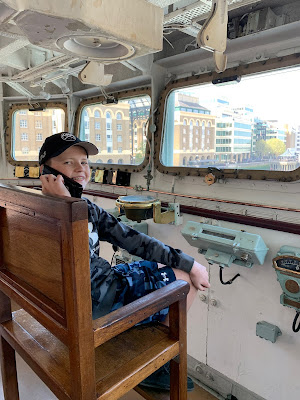We started our day heading down to the river and the HMS Belfast, commissioned in 1939. It struck a German mine in 1939 and spent two years in repairs. In 1942 it began escorting arctic supply conveys to the Soviet Union. They showed some video footage from the deck of the ship as it plowed through the icy waters and storms in the arctic. Every inch of the deck was covered in inches of ice. The crew constantly had to work to remove the ice before it got too thick and the weight made the ship too top heavy and turtled it. In 1944 it took part supporting the Normandy landings. She joined the Pacific fleet at the end of WWII and then served in the Korean War. She was decommissioned in 1967 and became a museum. Preservation efforts continue today.
Sunday, May 1, 2022
Day 4 - HMS Belfast
Picture taken from the London Bridge, first built by the Romans and the only bridge over the Thames until 1750. It has since be rebuilt several times.
There are new buildings on the skyline since I've visited last. We laughed at the broad tall one facing the river, saying it looks like a big space heater.
The ship carried two small sea planes that were launched by catapult and recovered from sea landings by a crane. They were used for reconnaisance until the ship was upgraded with a radar installation. She had a range of 9,000 miles at 13 knots (maximum was 35 knots).
This was inside one of the large gun turrets. The shells would come up on an ammo elevator from several decks below and get loaded and fired here. They had a sound track playing that simulated how noisy this space was. I think they said there were 17 men here when actively firing and they could fire every 6 seconds. The soundtrack counted 1-2-3-4-5-6 (boom) and repeated. Crowded and intense! The extended firing during D-day ended up cracking the crew toilets on board.
During 33 days off Normandy, the ship fired 4000 shells from her 6" turret guns and 1000 from her 4" guns.
That is one big anchor!
The ship has undergone major restoration several times, twice going into dry dock to inspect, repair and inspect the hull. The twin masts were replaced, paid for by Russians in appreciation for its support role in the arctic.
Captain Carson
Below decks where the regular crew bunked in hammocks.
Below decks where the shells were loaded in the ammo elevator to go up to the firing turret.
Hospital room. The beds are mounted on the support poles just like wide hammocks.
Pharmacy
These are "Neil Robertson" stretchers (invested in 1914). Made of bamboo with lots of straps, you can lift someone vertically through hatches and ladders if needed.
I would NOT want to get dental work done on a moving ship, especially in heavy seas.
A VERY heavy duty bread machine in the bakery.
We had a great view of the Tower of London and the 52 gun salute that was in honor of the Queen's Platinum Jubilee (75th year of rule). There were 3 cannon that were just above the river wall.
Subscribe to:
Post Comments (Atom)


















No comments:
Post a Comment